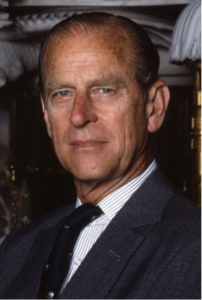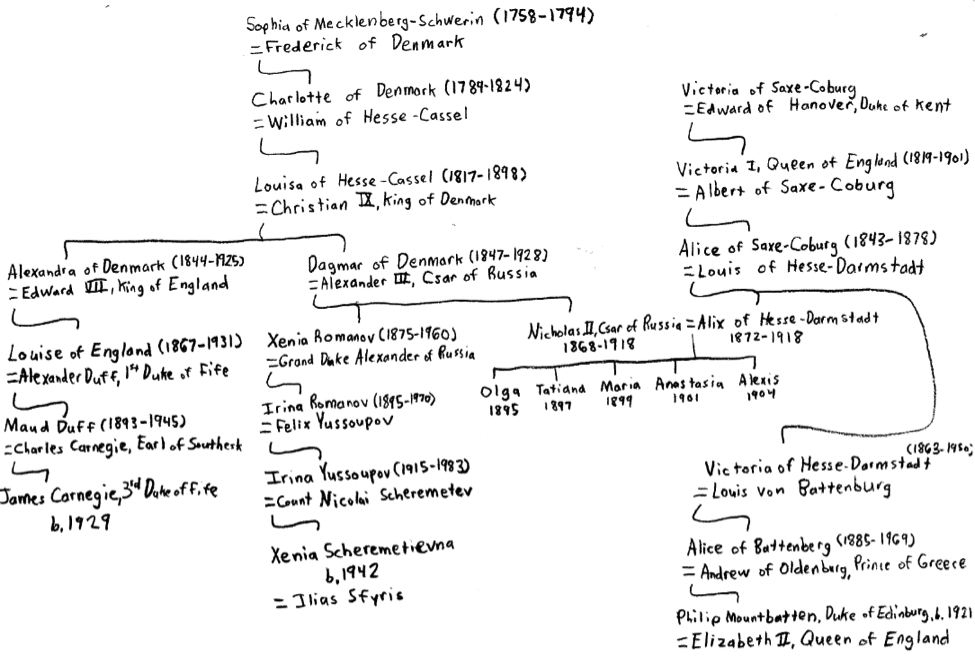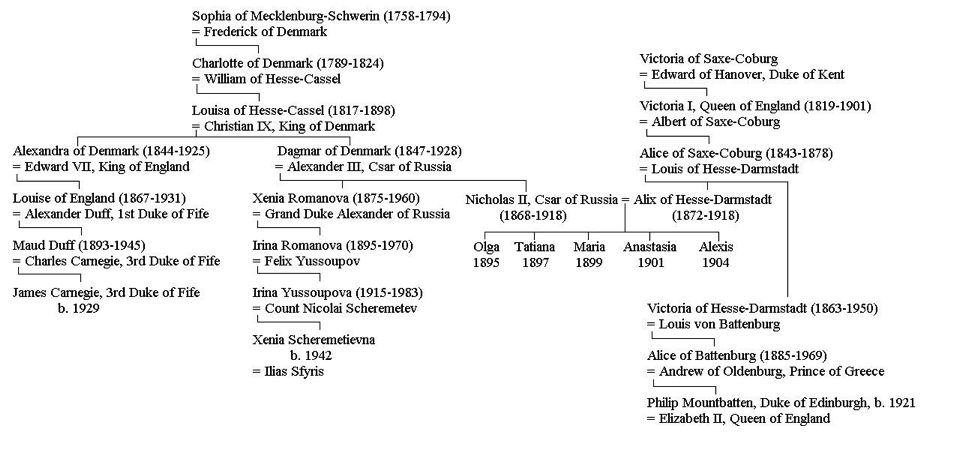 With Prince Philip’s recent death, several colleagues shared with me the story that recalled how in 1993 the Duke of Edinburgh had helped solve a Russian Romanov murder mystery. This was one of the earliest high profile uses of mitochondrial DNA to confirm historic remains, and something I frequently talked about in my early talks on using DNA in genealogy.[1] I gave two lectures at NEHGS while I was still in college in the early 2000s, the first one on Abraham Lincoln’s maternal ancestry (which I also discussed as having a possible mtDNA component, utilized nearly two decades later) and the other on DNA. These were also the only talks I made using overhead projector transparencies, before finally switching over to PowerPoint. They also both showed how designing charts has always gone hand-in-hand with my genealogical interests.
With Prince Philip’s recent death, several colleagues shared with me the story that recalled how in 1993 the Duke of Edinburgh had helped solve a Russian Romanov murder mystery. This was one of the earliest high profile uses of mitochondrial DNA to confirm historic remains, and something I frequently talked about in my early talks on using DNA in genealogy.[1] I gave two lectures at NEHGS while I was still in college in the early 2000s, the first one on Abraham Lincoln’s maternal ancestry (which I also discussed as having a possible mtDNA component, utilized nearly two decades later) and the other on DNA. These were also the only talks I made using overhead projector transparencies, before finally switching over to PowerPoint. They also both showed how designing charts has always gone hand-in-hand with my genealogical interests.
One of the most frequent comments on my posts concerns how I design my charts, which are largely made using Microsoft Paint, something several of my colleagues mock me about! I occasionally use Adobe Illustrator, but most of the charts that I design for books and articles are largely then redesigned by professional illustrators, so exactly how I made them initially is somewhat irrelevant. In grade school I frequently made elaborate charts by hand, showing how classmates of mine were cousins of cousins of cousins, etc., to one another. So, in a bit of nostalgia, I found the original handwritten chart I had made for my first DNA talk at NEHGS, showing how Prince Philip was matrilineally related to the last Tsarina and her children:
I would later make the same chart, using Microsoft Paint (obviously). Note that both charts I created were made with the genealogical customs I used at the time. Had I had the guidance of Scott Steward with his knowledge of contemporary names and titles, rather than “Retroactive surnames,” several of the names would have been altered appropriately, as they are shown in the ancestry of Archie Mountbatten-Windsor:
I know there are other ways to design charts, but for this I have chosen to stick with what I know. The mtDNA study involving the Russian and British royal families also served as one of the inspirations for the late William Addams Reitwiesner’s work Matrilineal Descents of the European royalty: A work in progress, which he first published in 1994. As mtDNA was certainly one of the earliest ways to combine genetics and genealogy, it certainly “flipped the script” somewhat, as so many genealogies have tended to be male-preferred (patrilineal descents of course also have genetic significance via Y-DNA). While I wrote over a year ago on another person’s challenges in getting DNA from members from the British royal family, I enjoyed recalling how Prince Philip was one of the earliest people to “draw blood” (as it was done then) for the sake of solving a historical mystery.
Note
[1] NEHGS Councilor Bryan Sykes (1947-2020) also discussed the Romanov DNA study in a chapter in his 2001 book The Seven Daughters of Eve (see page 61 of our Winter 2021 issue of American Ancestors for an obituary of Sykes).
Share this:
About Christopher C. Child
Chris Child has worked for various departments at NEHGS since 1997 and became a full-time employee in July 2003. He has been a member of NEHGS since the age of eleven. He has written several articles in American Ancestors, The New England Historical and Genealogical Register, and The Mayflower Descendant. He is the co-editor of The Ancestry of Catherine Middleton (NEHGS, 2011), co-author of The Descendants of Judge John Lowell of Newburyport, Massachusetts (Newbury Street Press, 2011) and Ancestors and Descendants of George Rufus and Alice Nelson Pratt (Newbury Street Press, 2013), and author of The Nelson Family of Rowley, Massachusetts (Newbury Street Press, 2014). Chris holds a B.A. in history from Drew University in Madison, New Jersey.View all posts by Christopher C. Child →

